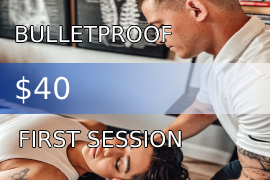How IASTM (instrument Assisted Soft Tissue Mobilization) is Different than traditional manual therapy
Manual therapy is when a clinician uses his or her hands to provide the treatment. During an IASTM treatment, your physical therapist will use an instrument (metal or plastic) with specific techniques to treat problem areas. This tool is gently (or vigorously) scraped and rubbed over your skin. The instrument is used to identify and release tightness in the fascial system.
How IASTM Works?
When your Physical Therapist uses an IASTM tool during your treatment, he or she will initially be searching for areas of fascial and muscle restrictions. Areas of restriction will have a different texture (typically course or crackly). Once your Physical Therapist hones in on these areas, they will perform various techniques to release them.
How does this work? As your practitioner is working the tool over your skin it is causing micro trauma to the affected tissues. This will lead to the initiation of the inflammatory response which will then cause resorption of excess scar tissue and fibrosis that was causing the restriction. Overall this helps to improve pain-free mobility.
When Would Your Physical Therapist use IASTM?
If you have any of these impairments, your Physical Therapist may choose to use IASTM to treat your condition.
- Pain with motion
- Loss of ROM (Range of Motion)
- Decreased muscle recruitment
- Excessive scar tissue formation
Conditions that may benefit from the application of IASTM techniques may include:
- Tendonitis and Tendonopathy
- Ligament sprains
- Scar tissue from surgery or trauma
- Plantar fasciitis
- Pes anserine bursitis
- Musculoskeletal imbalance
- Myofacial pain
What should I expect?
During a Physical Therapy session where IASTM is used, your Physical Therapist will expose the body part to be worked on. He or she will then use an IASTM tool to gently search for tissue restrictions. As the clinician searches for restrictions you may feel “gravely” sensations under the skin. While this is commonly uncomfortable, it should be easily tolerable. Once a restriction is found, the scraping will become more vigorous. At NO point during this procedure should you feel discomfort that you cannot tolerate.
After an IASTM session, your Physical Therapist will likely have you perform active motions or stretches to improve your mobility. These exercises help keep scar tissue or fascia restrictions from reforming. Following IASTM, it is very important to hydrate and stretch. Your clinician will be prescribing a specific regime following treatment that should be followed closely.
Current research?
One recent meta-analysis compared the use of hands-on myofascial release to the use of instrument myofascial release, like IASTM, for chronic low back pain. The results of the analysis found little difference in the two techniques for reducing pain. The IASTM technique did provide greater improvements in disability when compared to hands-on myofascial techniques.
Another systematic review in the journal Physical Therapy Reviews looked at 7 studies and compared IASTM to other techniques for musculoskeletal pain and dysfunction. The authors concluded that IASTM may have a positive effect on blood flow and tissue extensibility while reducing tissue viscosity and reducing the activity of pain receptors in tissue.
Do the results of any study mean that IASTM will or will not work well for you? Maybe, maybe not. But keep in mind that everyone is different, and your specific condition may respond in different ways to various treatments.
The best course of action: understand what treatments your PT is using for your condition and have a reasonable expectation of the outcome of such treatments. And if you have any questions about IASTM—or any other treatment—ask your Physical Therapist.

